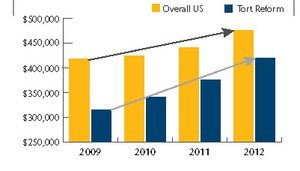By Dr. Ken Broda Bahm:
As a response to the perception of escalating jury awards in medical cases, a number of states have turned to legislative caps on noneconomic damages or overall damages. At last count, that preference for legislative limits on verdict amounts applies to all but 15 states (Alabama, Arizona, Arkansas, Connecticut, Delaware, Iowa, Kentucky, Minnesota, New Hampshire, New York, Pennsylvania, Rhode Island, Vermont, Washington, and Wyoming and the District of Columbia). All the rest have gone the way of caps. But the question is, do caps work? Should physicians, hospitals, and insurers be breathing a sigh of relief if their state has said “no” to runaway verdicts? The answer might surprise you. An analysis of trends in medical liability awards in high-risk jurisdictions and across the country (available here as a PDF download) was recently released by the Beazley Group underwriting company, and the report indicates that severe verdicts are increasing fastest in those states that have implemented damages caps. Pointing to California and Maryland as two tort reform states where verdict severity is still increasing significantly, the data also shows that the increase in verdict value is not limited to the worst venues, but is occurring in what have been seen as the safer venues as well.
Does that mean that caps are no good? Not necessarily, and I’ll take a closer look at the data below. But what it does mean is that caps are not, and were never, a foolproof insurance against escalating jury awards. That is due to the fact that, even as caps might reduce the overall caseload by making some cases less attractive to plaintiffs and their lawyers, they can increase the average value of those that remain by weeding out the low value cases. In addition, a motivated jury can still circumvent caps by loading up on those categories that are not subject to legislated limits, such as the uncapped economic damages. This post takes a look at the Beazley report and shares some thoughts on what methods, other than caps, defendants have for preventing runaway medical verdicts.
Increasing Verdict Severity in Tort Reform States
The most attention-gaining finding in the Beazley Group’s brief trend analysis is the comparison of increase between tort reform states and other states. The chart below shows severity of closed claims, defined as verdicts or settlements over $2 million, is increasing faster in those states with tort reform (the blue bars) than in states without (the yellow bars).
 “The severity trend over the past four closing years,” Beazley notes, “shows a higher rate of increase in the tort reform category.” Writing about these results, the healthcare business blog, Vital Signs notes, “The findings suggest the continued creativity of plaintiff lawyers and the desire of judges and juries to find ways around statutory caps and compensate sympathetic malpractice victims and their families.”
“The severity trend over the past four closing years,” Beazley notes, “shows a higher rate of increase in the tort reform category.” Writing about these results, the healthcare business blog, Vital Signs notes, “The findings suggest the continued creativity of plaintiff lawyers and the desire of judges and juries to find ways around statutory caps and compensate sympathetic malpractice victims and their families.”
Of course, it is also worth noting that the proportion of severe verdicts is still higher in the uncapped than the capped states. The fact that the latter group is catching up doesn’t necessarily mean that caps are ineffectual. But for those caps, the verdicts could be even higher, or increasing even faster.
But the finding of high verdicts persisting and increasing even after caps is consistent with other research (Avraham & Bustos, 2010) showing that caps may increase the overall costs of litigation by drawing out the time to conclusion. In situations where jurors either know or can guess at the existence of a cap, that knowledge could also set a high anchor and lead to an increase in awards. Psychologically, it is the same effect at work when a store’s sign indicating “limit three per customer” increases the chances that customers will buy three items. If you know that you can award up to $250,000 in noneconomic loss, then you may have set the initial anchor at $250,000.
Heading Off the Big Verdict
All of this goes to show what doctors, insurers and legislators should already know: Caps are not a panacea. Defendants still need to take great care in addressing damages in highly emotional medical cases. Here are a few ideas for dealing with that.
Look for What Could Motivate a Large Award
Many commentators, like the Vital Signs blog above, are quick to point to sympathy as a driving force in runaway medical verdicts. In my experience, however, it generally isn’t sympathy, it is anger. A sad juror is not nearly as dangerous to the defense as a mad juror. Litigators need to consider the factors that promote anger — bad intent, deception, arrogance — as well as anything else that could leave a juror wanting revenge and not simply justice.
Consider the “Punitive Possibility” In All Damage Categories
It is a bad habit for litigators to only be thinking about the possibility of a punishment-motivated award when there is a line for punitive damages on the verdict form. Jurors have other ways to punish. For example, they can buy into a ridiculously overpriced life-care plan if they think the defendant has it coming, or needs to hear a message. That can serve as a conscious or unconscious way of evading a cap on noneconomic damages.
Remember to Think of Anchors
The robust effect of anchoring has been shown in laboratory experiments (the most famous of which (Tversky & Kahneman, 1974) being the demonstration that subjects’ estimates of the number of African countries in the UN can be strongly determined by the spin of a roulette wheel — simply seeing a higher number causes subjects to anchor on the higher guess and the same goes for a lower number). That finding does not completely translate to a litigation setting, because jurors are apt to be skeptical of attorney-suggested numbers, but as we’ve written, the use of high or low requested damages numbers can still play an important role in anchoring jurors on those numbers, and that effect applies to both plaintiffs and defendants.
Addressing the broader question of whether state legislators can effectively fence jurors in, I am reminded of the first Jurassic Park movie, where the mathematician Ian Malcolm played by Jeff Goldblum, is told there can be no chance the genetically recovered dinosaurs will breed in captivity because they are all female. Malcolm responded “Life will find a way” (and that is indeed what happens in the movie, with terrifying consequences). Perhaps the lesson of caps is as simple as that: Jurors will find a way. And if that is true, the best protection against a runaway verdict is going to be in your trial message and not in a damage cap.
______
Other Posts on Damages:
- Spot the Jurors Who Feel Entitled to Award Higher Damages
- When Arguing Damages, “Drop Anchor” Even in Murky Waters
- A Mixture of Justice and Revenge: Target Juror Psychology in Awarding Damages
- Get the Gist of How Jurors Decide Damage Numbers
______
Photo Credit: sk8geek, Flickr Creative Commons
